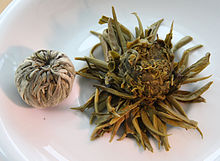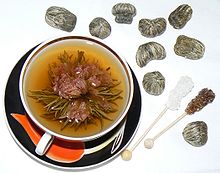- Flowering tea
-
Flowering tea or blooming tea (Chinese: 香片, 工艺茶, or 开花茶) consist each of a bundle of dried tea leaves wrapped around one or more dried flowers.[1] These are made by binding tea leaves and flowers together into a bulb and are then set to dry.[1] When steeped, the bundle expands and unfurls in a process that emulates a blooming flower,[2] while the flowers inside emerge as the centerpiece.[3] Typically they are sourced from the Yunnan province of China.[4] Flowers commonly used in flowering teas include globe amaranth, chrysanthemum, jasmine, lily, hibiscus, and osmanthus.[2]
It remains uncertain whether flowering tea was developed in the 1980s or was a much older invention of China.[2][5]
Flowering tea is generally served in containers made of glass, or other transparent material, so that the flowering effect can be seen. The bundles can usually be reused two or three times without the tea becoming bitter.[5]
References
- ^ a b Gold, Cynthia; Stern, Lisë (2010). Culinary tea: More than 150 recipes steeped in tradition from around the world. Philadelphia: Running Press. p. 274. ISBN 9780762437733. http://books.google.com/books?id=ccH3S3giAxgC.
- ^ a b c "On Food: Stop and savor the flowering teas", Hsiao-Ching Chou, Seattle Post-Intelligencer, May 1, 2007.
- ^ Richardson, Lisa Boalt (2009). Tea with a twist: Entertaining and cooking with tea. Eugene, OR: Harvest House Publishers. ISBN 9780736925792. http://books.google.com/books?id=vb4LeqV7pC4C.
- ^ "The Cup that Still Cheers", Caterer and Hotelkeeper, 20 October 2005.
- ^ a b "What is Flowering Tea?", WiseGEEK.
External links
 Media related to Flowering tea at Wikimedia CommonsCategories:
Media related to Flowering tea at Wikimedia CommonsCategories:
Wikimedia Foundation. 2010.


